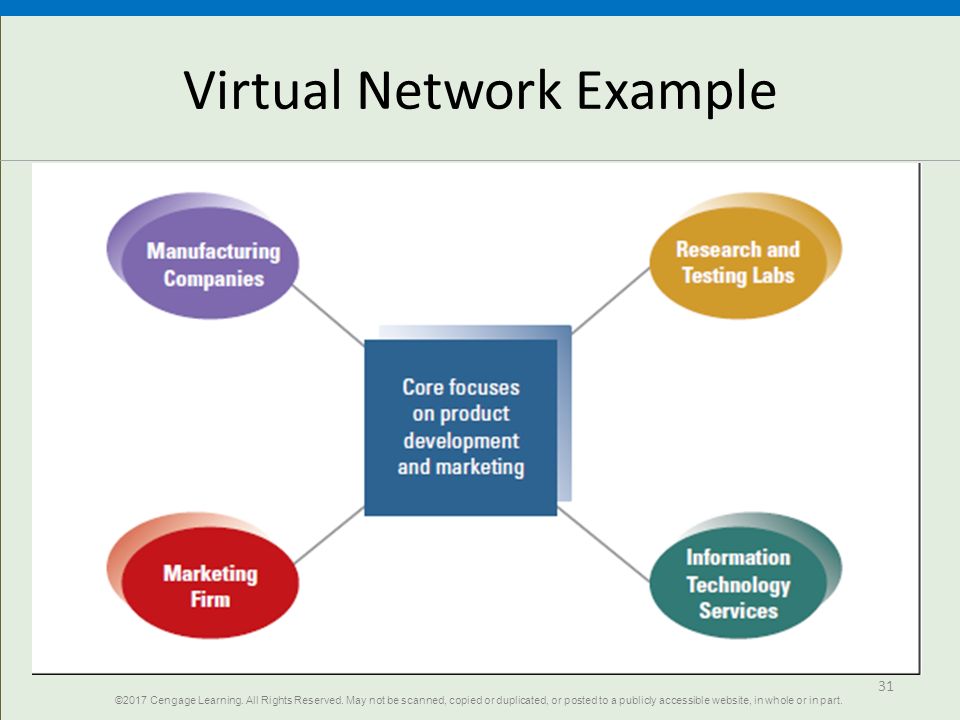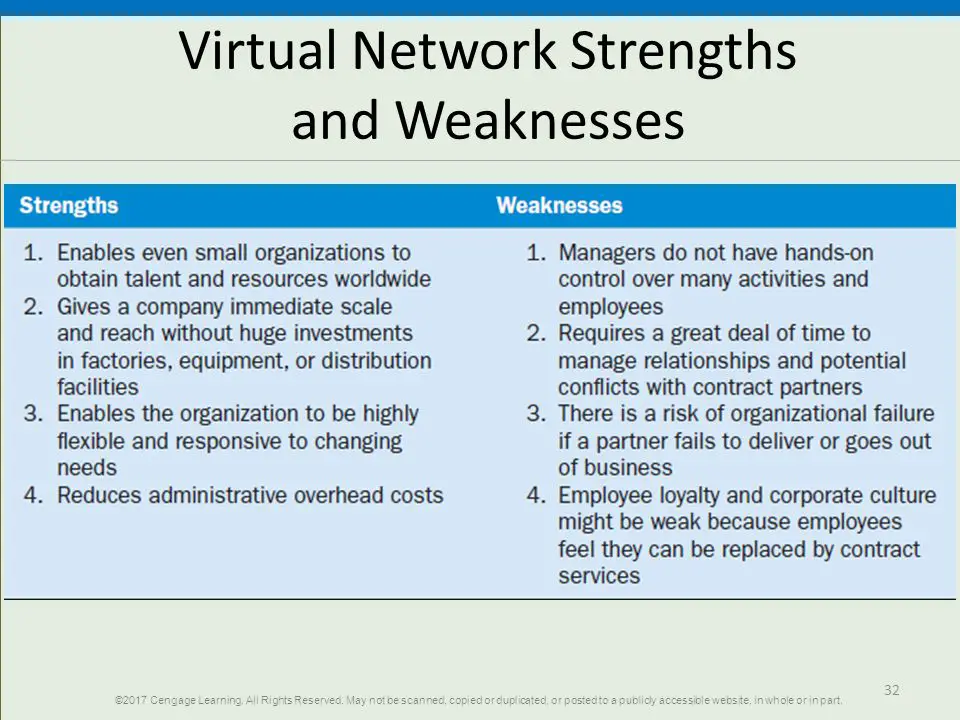Virtual Network
Virtual Network Structure and Outsourcing
A recent development in organization designOpens in new window extends the concept of horizontal coordination and collaborationOpens in new window beyond the boundaries of the traditional organization.
The most widespread design trend in recent years has been the outsourcing of various parts of the organization to outside partners.
Outsourcing means to contract out certain tasks or functions, such as manufacturing, human resources, or credit processing, to other companies.
All sorts of organizations are jumping on the outsourcing bandwagon. The Ohio State UniversityOpens in new window outsourced its parking system.
The City of Maywood, CaliforniaOpens in new window, decided to outsource everything from street maintenance to policing and public strategy. The U.S. military is also increasingly using private military company contractors to handle just about everything except the core activity of fighting battles and securing defensive positions.
In the business world, HondaOpens in new window once designed all its new technologies in-house but turned to outsourcing due to high costs and rapid technology advancements for electric vehicles and self-driving vehicles.
For example, it has a deal with Chinese start-up Sense Time CompanyOpens in new window to build camera software for self-driving vehicles, uses a semi-autonomous driving system from German supplier BoschOpens in new window, and farmed out the development of an electric motor to a joint venture between Honda and Hitachi’s auto parts division, in which HitachiOpens in new window has the majority stake.
In the 1960s, founder Soichiro Honda said, “We refuse to depend on anyone else,” but the industry has changed. Today, Honda’s CEO says, “We want to work with those that possess the best technology, regardless of whether they are Japanese suppliers or American ones or European ones.”
Once, a company’s units of operation “were either within the organization and ‘densely connected’ or they were outside the organization and not connected at all,” as one observer phrased it.
Today, the lines are so blurred that it can be difficult to tell what is part of the organization and what is not. IBMOpens in new window handles back-office operations for many large companies, but it also outsources some of its own activities to other firms, which in turn may farm out some of their functions to still other organizations.
A few organizations carry outsourcing to the extreme to create a virtual network structure.
With a virtual network structure, sometimes called a a modular structure, the firm subcontracts most of its major functions or processes to separate companies and coordinates their activities from a small headquarters organization.
How the Structure Works
The virtual network organization may be viewed as a central hub surrounded by a network of outside specialists. With a network structure, rather than being housed under one roof or located within one organization, services such as accounting, design, manufacturing, marketing, and distribution are outsourced to separate companies or individuals that are connected electronically to a central office.
Organizational partners located in different parts of the world may use networked computers or the Internet to exchange data and information so rapidly and smoothly that a loosely connected network of suppliers, manufacturers, and distributors can look and act like one seamless company. The virtual network form incorporates a free market style to replace the traditional vertical hierarchy. Subcontractors may flow into and out of the system as needed to meet changing needs.
When a business chooses to use a network structure, the hub maintains control over processes in which it has world-class or difficult-to-imitate capabilities and then transfers other work activities—along with the control over them—to other organizations.
These partner organizations organize and accomplish their work using their own ideas, and tools. The idea is that a firm can concentrate on what it does best and contract out everything else to companies with distinctive competence in those specific areas, enabling the organization to do more with less.
 Figure X-1 Example of Virtual Network Structure | Credit — Slide Player Opens in new window
Figure X-1 Example of Virtual Network Structure | Credit — Slide Player Opens in new window
|
NikeOpens in new window was a pioneer in using the virtual network structure, so much that the widespread trend toward network structures has been referred to as Nikefication.
Executives at NikeOpens in new window were quick to realize that design and marketing provided their company’s competitive advantageOpens in new window, so they kept these tasks in-house and formed a network of partners to handle other functions, such as manufacturing.
The company’s founder, Phil Knight, came up with the idea of outsourcing manufacturing jobs to cut costs. Becoming an early adopter of the virtual organization design propelled Nike into one of the biggest athletic footwear and apparel companies in the world.
With a network structure, it is difficult to answer the question “Where is the organization?” in traditional terms. The different organizational parts are drawn together contractually and coordinated electronically, creating a new form of organization.
Much like building blocks, parts of the network can be added or taken away to meet changing needs. Figure X-1 (shown earlier) illustrates a simplified network structure for a business such as Nike, showing some of the functions that can be outsourced to other companies.
Strengths and Weaknesses
Figure X-2 summarizes the strengths and weaknesses of the virtual network structure.
 Figure X-2 Virtual Network Strengths and Weaknesses | Credit — Slide Player Opens in new window
Figure X-2 Virtual Network Strengths and Weaknesses | Credit — Slide Player Opens in new window
|
One of the major strength is that the organization, no matter how small, can be truly global, drawing on resources worldwide to achieve the best quality and price and then selling products or services worldwide just as easily through subcontractors.
- The network structure also enables a new or small company to develop products or services and get them to market rapidly without huge investments in factories, equipment, warehouse, or distribution facilities.
- The ability to arrange and rearrange resources to meet changing needs and best serve customers gives the network structure extreme flexibility and rapid response.
- New technologies can be developed quickly by tapping into a worldwide network of experts. The organization can continually redefine itself to meet changing technologies and shifting product or market opportunities.
- A final strength is reduced administrative overhead. Large teams of staff specialists and administrators are not needed. Managerial and technical talent can be focused on key activities that provide competitive advantage while other activities are outsourced.
The virtual network structure also has a number of weaknesses. The primary weakness is a lack of control. K’Nex Brands LP, a family-owned toy company near Philadelphia, brought most of the production of its plastic building toys back to its factory in the United States from subcontractors in China, for instance, to maintain greater control over quality and materials.
The network structure takes decentralization to the extreme. Managers do not have all operations under their jurisdiction and must rely on contracts, coordination, and negotiation to hold things together. This also means increased time spent managing relationships with partners and resolving conflicts.
A problem of equal importance is the risk of failure if one organizational partner fails to deliver, has a plant burn down, or goes out of business. Managers in the headquarters organization have to act quickly to spot problems and find new arrangements.
Finally, from a human resource perspective, employee loyalty can be weak in a network organization because of concerns over job security. Employees may feel that they can be replaced by contract services.
In addition, it is more difficult to develop a cohesive corporate culture. Turnover may be higher because emotional commitment between the organization and employees is low. With changing products, markets, and partners, the organization may need to reshuffle employees at any time to get the correct mix of skills and capabilities.
| Remember This |
|---|
|
The Series:
- Organization Structures Opens in new window
- Functional Structure Opens in new window
- Divisional Structure Opens in new window
- Matrix Structure Opens in new window
- Geographical Structure Opens in new window
- Virtual Network Structure and Outsourcing Opens in new window
- Holacracy Team Structure Opens in new window
- Adhocracy Opens in new window
- Research data for this work have been adapted from the manual:
- Organization Theory & Design By Richard L. Daft

